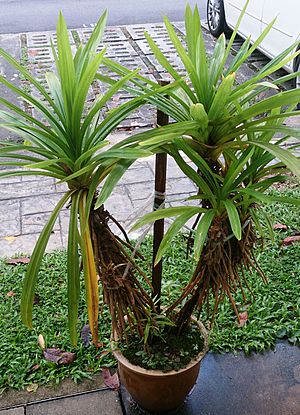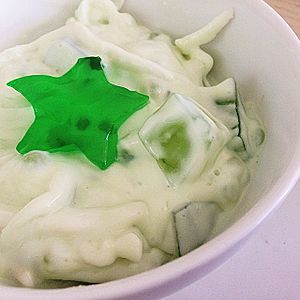Pandanus amaryllifolius facts for kids
Quick facts for kids Pandanus amaryllifolius |
|
|---|---|
 |
|
| Scientific classification | |
| Genus: |
Pandanus
|
| Species: |
amaryllifolius
|
| Synonyms | |
|
|
Pandanus amaryllifolius is a tropical plant often called pandan. It belongs to the Pandanus group, also known as screwpines. Pandan is famous for its sweet-smelling leaves, which are used a lot in cooking across Southeast Asia and South Asia. Think of it as a natural flavor enhancer!
Contents
Where Pandan Grows
Pandan is a special plant because it doesn't grow wild in nature anymore. It's a "cultigen," meaning people have grown and cared for it for a very long time. Scientists believe it was first grown in the Maluku Islands.
This plant can't make seeds on its own. It can only grow new plants from its "suckers" (small shoots that grow from the base) or from cuttings. This means every pandan plant you see today came from another pandan plant that people grew. It is now grown widely in many parts of Asia.
What Pandan Looks Like
Pandan is an upright, green plant. Its leaves are long, narrow, and shaped like blades, fanning out from the stem. It also has woody aerial roots that grow above the ground.
The special smell of pandan comes from a natural chemical called 2-acetyl-1-pyrroline. This same chemical gives white bread, jasmine rice, and basmati rice their typical smell. Pandan plants rarely grow flowers, so they are usually grown from cuttings.
How Pandan is Used
In Cooking


The taste of pandan is often described as floral, sweet, or like vanilla. It usually has a subtle flavor and scent.
In countries like Singapore, Malaysia, Indonesia, and the Philippines, pandan is a very common ingredient. People often call it pandan or pandan wangi (which means fragrant pandan). The green juice from its leaves is used as a natural food coloring and flavor in many traditional cakes called kue. Some examples include klepon, kue putu, dadar gulung, and pandan cake. It's also used in buko pandan salad and buko pandan cake. Sometimes, a tied knot of pandan leaves is added to fragrant coconut rice to make it smell even better.
In Sri Lanka, pandan is called rampé and is grown in almost every home. Most Sri Lankan dishes use these leaves for their aroma, often with curry leaves. In Bangladesh, it's called pulao pata. In the Maldives, it's called ran’baa. It's used to make dishes like pulao and biryani taste better. It can even make regular rice dishes smell and taste like expensive basmati rice.
You can use pandan leaves fresh or dried. You can also find them frozen in Asian grocery stores in places where the plant doesn't grow naturally. They add a nutty, plant-like smell that makes many Asian dishes, especially rice dishes, desserts, and cakes, taste better.
Sometimes, the leaves are soaked in coconut milk, and then this flavored milk is added to a dish. The leaves can also be tied in a bunch and cooked directly with the food. Some people even weave the leaves into a basket to cook rice in! Pandan chicken, a Thai dish, involves wrapping chicken pieces in pandan leaves before frying them.
Pandan leaves and their extract have also been used to help keep food fresh. This is because they have properties that can fight against certain bacteria and mold.
You can buy bottled pandan extract in shops. These often have green food coloring added to them.
For Fragrance and Traditional Uses
Pandan leaves are also used in the perfume industry because of their pleasant smell. In some traditional practices, pandan essence can be used instead of vanilla essence.
Studies have shown that P. amaryllifolius can help keep away American cockroaches.
As an Air Freshener
Because the leaves smell so nice, they can be used as natural air fresheners. In Thailand, some taxi drivers even use pandan leaves in their cars to make them smell fresh.
See also
 In Spanish: Pandano para niños
In Spanish: Pandano para niños

